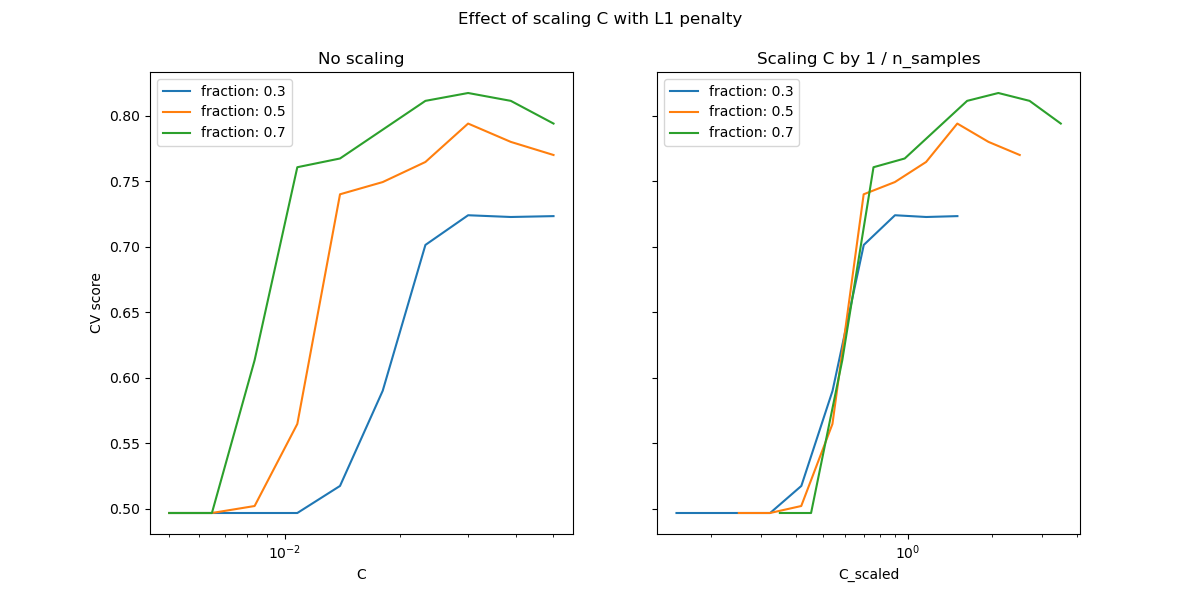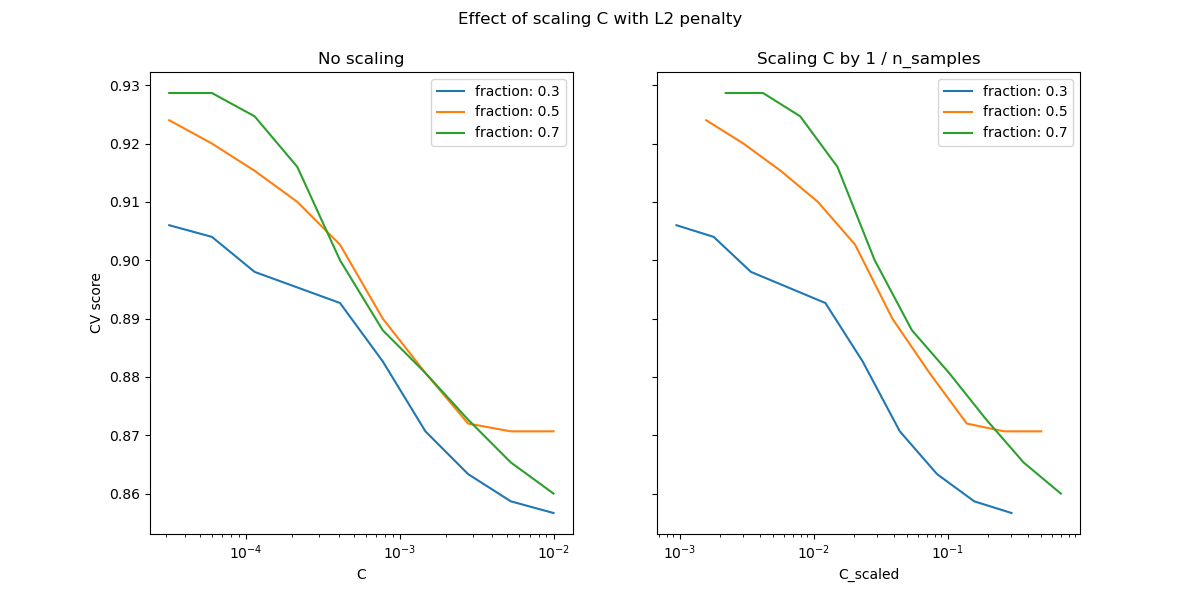Note
Click here to download the full example code or to run this example in your browser via Binder
Scaling the regularization parameter for SVCs¶
The following example illustrates the effect of scaling the regularization parameter when using Support Vector Machines for classification. For SVC classification, we are interested in a risk minimization for the equation:
where
\(C\) is used to set the amount of regularization
\(\mathcal{L}\) is a
lossfunction of our samples and our model parameters.\(\Omega\) is a
penaltyfunction of our model parameters
If we consider the loss function to be the individual error per sample, then the data-fit term, or the sum of the error for each sample, will increase as we add more samples. The penalization term, however, will not increase.
When using, for example, cross validation, to
set the amount of regularization with C, there will be a
different amount of samples between the main problem and the smaller problems
within the folds of the cross validation.
Since our loss function is dependent on the amount of samples, the latter
will influence the selected value of C.
The question that arises is “How do we optimally adjust C to
account for the different amount of training samples?”
In the remainder of this example, we will investigate the effect of scaling
the value of the regularization parameter C in regards to the number of
samples for both L1 and L2 penalty. We will generate some synthetic datasets
that are appropriate for each type of regularization.
# Author: Andreas Mueller <amueller@ais.uni-bonn.de>
# Jaques Grobler <jaques.grobler@inria.fr>
# License: BSD 3 clause
L1-penalty case¶
In the L1 case, theory says that prediction consistency (i.e. that under
given hypothesis, the estimator learned predicts as well as a model knowing
the true distribution) is not possible because of the bias of the L1. It
does say, however, that model consistency, in terms of finding the right set
of non-zero parameters as well as their signs, can be achieved by scaling
C.
We will demonstrate this effect by using a synthetic dataset. This dataset will be sparse, meaning that only a few features will be informative and useful for the model.
from sklearn.datasets import make_classification
n_samples, n_features = 100, 300
X, y = make_classification(
n_samples=n_samples, n_features=n_features, n_informative=5, random_state=1
)
Now, we can define a linear SVC with the l1 penalty.
We will compute the mean test score for different values of C.
import numpy as np
import pandas as pd
from sklearn.model_selection import validation_curve, ShuffleSplit
Cs = np.logspace(-2.3, -1.3, 10)
train_sizes = np.linspace(0.3, 0.7, 3)
labels = [f"fraction: {train_size}" for train_size in train_sizes]
results = {"C": Cs}
for label, train_size in zip(labels, train_sizes):
cv = ShuffleSplit(train_size=train_size, test_size=0.3, n_splits=50, random_state=1)
train_scores, test_scores = validation_curve(
model_l1, X, y, param_name="C", param_range=Cs, cv=cv
)
results[label] = test_scores.mean(axis=1)
results = pd.DataFrame(results)
import matplotlib.pyplot as plt
fig, axes = plt.subplots(nrows=1, ncols=2, sharey=True, figsize=(12, 6))
# plot results without scaling C
results.plot(x="C", ax=axes[0], logx=True)
axes[0].set_ylabel("CV score")
axes[0].set_title("No scaling")
# plot results by scaling C
for train_size_idx, label in enumerate(labels):
results_scaled = results[[label]].assign(
C_scaled=Cs * float(n_samples * train_sizes[train_size_idx])
)
results_scaled.plot(x="C_scaled", ax=axes[1], logx=True, label=label)
axes[1].set_title("Scaling C by 1 / n_samples")
_ = fig.suptitle("Effect of scaling C with L1 penalty")

Here, we observe that the cross-validation-error correlates best with the
test-error, when scaling our C with the number of samples, n.
L2-penalty case¶
We can repeat a similar experiment with the l2 penalty. In this case, we
don’t need to use a sparse dataset.
In this case, the theory says that in order to achieve prediction consistency, the penalty parameter should be kept constant as the number of samples grow.
So we will repeat the same experiment by creating a linear SVC classifier
with the l2 penalty and check the test score via cross-validation and
plot the results with and without scaling the parameter C.
rng = np.random.RandomState(1)
y = np.sign(0.5 - rng.rand(n_samples))
X = rng.randn(n_samples, n_features // 5) + y[:, np.newaxis]
X += 5 * rng.randn(n_samples, n_features // 5)
model_l2 = LinearSVC(penalty="l2", loss="squared_hinge", dual=True)
Cs = np.logspace(-4.5, -2, 10)
labels = [f"fraction: {train_size}" for train_size in train_sizes]
results = {"C": Cs}
for label, train_size in zip(labels, train_sizes):
cv = ShuffleSplit(train_size=train_size, test_size=0.3, n_splits=50, random_state=1)
train_scores, test_scores = validation_curve(
model_l2, X, y, param_name="C", param_range=Cs, cv=cv
)
results[label] = test_scores.mean(axis=1)
results = pd.DataFrame(results)
import matplotlib.pyplot as plt
fig, axes = plt.subplots(nrows=1, ncols=2, sharey=True, figsize=(12, 6))
# plot results without scaling C
results.plot(x="C", ax=axes[0], logx=True)
axes[0].set_ylabel("CV score")
axes[0].set_title("No scaling")
# plot results by scaling C
for train_size_idx, label in enumerate(labels):
results_scaled = results[[label]].assign(
C_scaled=Cs * float(n_samples * train_sizes[train_size_idx])
)
results_scaled.plot(x="C_scaled", ax=axes[1], logx=True, label=label)
axes[1].set_title("Scaling C by 1 / n_samples")
_ = fig.suptitle("Effect of scaling C with L2 penalty")

So or the L2 penalty case, the best result comes from the case where C is
not scaled.
plt.show()
Total running time of the script: ( 0 minutes 6.038 seconds)